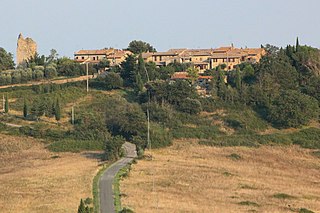
Volterra is a walled mountaintop town in the Tuscany region of Italy. Its history dates from before the 8th century BC and it has substantial structures from the Etruscan, Roman, and Medieval periods.

Méditerranée[me.di.tɛ.ʁa.ne] was a department of the First French Empire in present-day Italy. It was named after the Mediterranean Sea. It was formed in 1808, when the Kingdom of Etruria was annexed directly to France. Its capital was Livorno.

The Province of Pisa is a province in the Tuscany region of central Italy. Its capital is the city of Pisa. With an area of 2,448 square kilometres (945 sq mi) and a total population of 421,642, it is the second most populous and fifth largest province of Tuscany. It is subdivided into 37 comuni.

Montecatini Val di Cecina is a small hilltown and comune in the province of Pisa in Tuscany. Located approximatively 60 kilometres south of Pisa, the medieval town sits on the Poggio la Croce hill overlooking the Cecina Valley and the larger hilltown of Volterra, which lies just 15 km away.

The Republic of Pisa was a de facto independent state centered on the Tuscan city of Pisa, which existed from the 11th to the 15th century. It rose to become an economic powerhouse, a commercial center whose merchants dominated Mediterranean and Italian trade for a century. before being surpassed and superseded by the Republic of Genoa.

Montaione is a comune (municipality) in the Metropolitan City of Florence in the Italian region Tuscany, located about 35 kilometres (22 mi) southwest of Florence.

Castelnuovo di Val di Cecina is a comune (municipality) in the Province of Pisa in the Italian region Tuscany, located about 70 kilometres (43 mi) southwest of Florence and about 70 km southeast of Pisa.

Lajatico is a comune (municipality) in the Province of Pisa in the Italian region Tuscany, located about 50 kilometers (31 mi) southwest of Florence and about 40 kilometers (25 mi) southeast of Pisa. Lajatico sits in mainly hilly terrain at variable elevations from 100 to 650 meters above sea level) and dominates both the end of the Valdera valley and the opening of the valley known as Val di Cecina.

Orciano Pisano is a comune (municipality) in the Province of Pisa in the Italian region Tuscany, located about 70 kilometres (43 mi) southwest of Florence and about 25 kilometres (16 mi) southeast of Pisa, in the Pisan Hills.

Pomarance is a comune (municipality) in the Province of Pisa in the Italian region Tuscany, located about 60 kilometres (37 mi) southwest of Florence and about 60 km southeast of Pisa.

Francesco da Volterra was an Italian painter. He resided in Pisa from 1370–1372, where, from the records of the Campo Santo, he painted the History of Job on the south wall. Like the rest of the earlier pictures in the Campo Santo, it is now almost obliterated, but some idea of its weird realism may still be formed from Lasinio's Pitture del Campo Santo and other reproductions in Italian books on art. Francesco da Volterra is supposed to have been identical with Francesco di Maestro Giotto, a painter of Florence, whose name occurs in the records of the city Guild for 1341.

San Dalmazio is a frazione of the comune of Pomarance, in Tuscany, Province of Pisa, in central Italy.
Cassa di Risparmio di Pisa is a former Italian saving bank and charity organization, based in Pisa, Tuscany. The bank was spin off into a banking foundation and a Società per Azioni in 1992.
Cassa di Risparmio di Volterra S.p.A. is an Italian saving bank based in Volterra, in the Province of Pisa, Tuscany. The bank was owned by the banking foundation of the same name for 75% stake. Cassa di Risparmio di San Miniato owned 20% and Fondazione Cassa di Risparmio di San Miniato owned an additional 5% stake.

Saline di Volterra is a village in Tuscany, central Italy, administratively a frazione of the comune of Volterra, province of Pisa. At the time of the 2001 census its population was 1,218.

Mazzolla is a village in Tuscany, central Italy, administratively a frazione of the comune of Volterra, province of Pisa. At the time of the 2001 census its population was 46.

Montemiccioli is a village in Tuscany, central Italy, administratively a frazione of the comune of Volterra, province of Pisa. At the time of the 2006 parish census its population was 95.

Buriano is a village in Tuscany, central Italy, administratively a frazione of the comune of Montecatini Val di Cecina, province of Pisa.

Villamagna Altarpiece is a 1521 oil on panel painting by Rosso Fiorentino, produced for Pieve dei Santi Giovanni Battista e Felicita, Villamagna's parish church, where it remained until the mid 1860s. It is now in the Diocesan Museum in Volterra. The artist's second commission in Volterra after Deposition, it is signed and dated in the lower left-hand corner. To the left of the Madonna and Child is John the Baptist in his camel-skin tunic and holding a cross, whilst to the left is Saint Bartholomew holding an open book and the knife used to flay him.



















